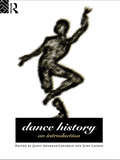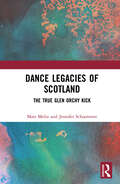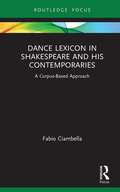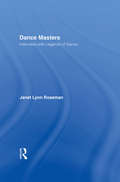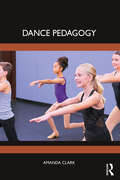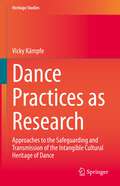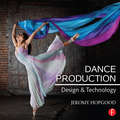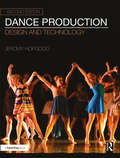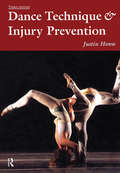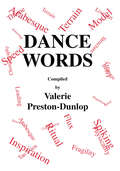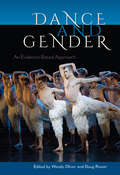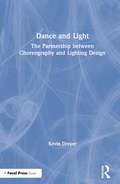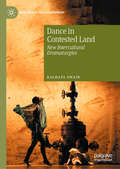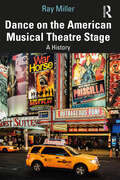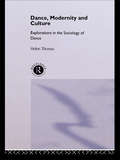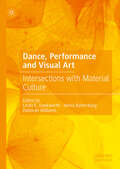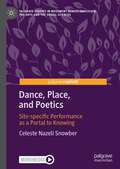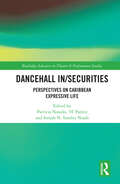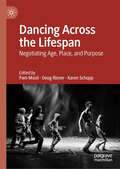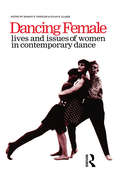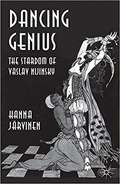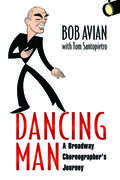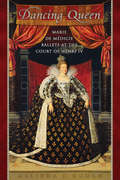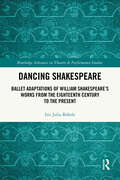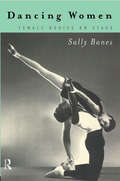- Table View
- List View
Dance History: An Introduction
by Janet Adshead-Lansdale June LaysonOriginally published in 1983 the first edition rapidly established itself as a core student text. Now fully revised and up-dated it remains the only book to address the rationale, process, techniques and methodologies specific to the study of dance history. For the main body of the text which covers historical studies of dance in its traditional and performance contexts, the editors have brought together a team of internationally known dance historians. Roger Copeland and Deborah Jowitt each take a controversial look at the modern American dance. Kenneth Archer and Millicent Hodson explain the processes they use when reconstructing 'lost' ballets, and Theresa Buckland and Georgina Gore write on traditional dance in England and West Africa respectively. With other contributions on social dance, ballet, early European modern dance and feminist perspectives on dance history this book offers a multitude of starting points for studying dance history as well as presenting examples of dance writing at its very best. Dance History will be an essential purchase for all students of dance.
Dance Legacies of Scotland: The True Glen Orchy Kick
by Mats Melin Jennifer SchoonoverDance Legacies of Scotland compiles a collage of references portraying percussive Scottish dancing and explains what influenced a wide disappearance of hard-shoe steps from contemporary Scottish practices. Mats Melin and Jennifer Schoonover explore the historical references describing percussive dancing to illustrate how widespread the practice was, giving some glimpses of what it looked and sounded like. The authors also explain what influenced a wide disappearance of hard-shoe steps from Scottish dancing practices. Their research draws together fieldwork, references from historical sources in English, Scots, and Scottish Gaelic, and insights drawn from the authors’ practical knowledge of dances. They portray the complex network of dance dialects that existed in parallel across Scotland, and share how remnants of this vibrant tradition have endured in Scotland and the Scottish diaspora to the present day. This book will be of interest to scholars and students of Dance and Music and its relationship to the history and culture of Scotland.
Dance Lexicon in Shakespeare and His Contemporaries: A Corpus Based Approach (Studies in Performance and Early Modern Drama)
by Fabio CiambellaThis book provides a thorough analysis of terpsichorean lexis in Renaissance drama. Besides considering not only the Shakespearean canon but also the Bard’s contemporaries (e.g., dramatists as John Marston and Ben Jonson among the most refined Renaissance dance aficionados), the originality of this volume is highlighted in both its methodology and structure. As far as methods of analysis are concerned, corpora such as the VEP Early Modern Drama collection and EEBO, and corpus analysis tools such as #LancsBox are used in order to offer the widest range of examples possible from early modern plays and provide co-textual references for each dance. Examples from Renaissance playwrights are fundamental for the analysis of connotative meanings of the dances listed and their performative, poetic and metaphoric role in sixteenth- and seventeenth-century drama. This study will be of great interest to Renaissance researchers, lexicographers and dance historians.
Dance Masters: Interviews with Legends of Dance
by Janet Lynn RosemanDance Masters is a lively ensemble of conversations with seven celebrated dancers and choreographers. In these intimate interviews, dance critic Janet Lynn Roseman probes the heart of dance: * The creative process * The role of dream and rituals * The interplay between dancer and audience * The spiritual aspects of performance These dance masters offer rare insights into the internal world of the artist as they reveal their philosophies on dance training, discuss their mentors, and speak candidly about the artistic process of dance-making and how it actually feels to dance.
Dance Pedagogy
by Amanda ClarkDance Pedagogy is a comprehensive resource designed for dance students and teaching artists to develop skills and strategies in the multifaceted practice of teaching dance.This invaluable resource features essential components and considerations necessary for the dance teacher in any setting, including the private and community sector, university setting, and professional venues. Five distinct units provide insight into the paradigm, learning process, class environment factors, planning, and delivery of the dance class in a broad context through the use of examples within the dance forms of ballet, jazz, modern, tap, and hip-hop. Readers intently explore cognitive and motor learning, strategies for developing curricula and lesson plans, and methods of delivering material to students. Basic principles of anatomy, understanding student behavior and participation, the importance of diversity, equity, inclusion and accessibility (IDEA), music concepts for the dancer, injury prevention, and classroom management are included to provide a well-rounded approach to the many challenges faced in the classroom.Dance Pedagogy provides the most holistic approach available in the art of teaching dance and is a core textbook for academic courses related to Dance Teaching Methods as well as an invaluable handbook for practicing dance teachers.
Dance Practices as Research: Approaches to the Safeguarding and Transmission of the Intangible Cultural Heritage of Dance (Heritage Studies)
by Vicky KämpfeThis book contributes to the growing scientific literature on ‘intangible cultural heritage’ – determined by UNESCO to be particularly worthy of safeguarding and transmission – by advancing a theoretical-analytical framework for the (in)tangible cultural heritage of dance. By exploring the potential of the ‘intangible materiality’ of dance practice the book argues that implementing the concept of a ‘performative dance-archive’ creates a new analytic field: research in praxis. The concept of the ‘performative dance-archive’ draws out the potential for safeguarding and transmission of dance heritage, but also the challenges of the opposition between living heritage and the codifying of cultural inventories. This book uses the formal and contextual transformation of Argentine tango and German modern dance to discuss this ambiguity of intangible heritage and how the “performative dance-archive” creates a cognitive, empractical approach to determine, archive, and distribute dance knowledge. This is a timely methodological intervention in the context of the increasing importance of the intangible cultural heritage. It enables us to re-revise the concept of (im)materiality and the specific knowledges within cultural practice as a necessary fundamental category for research-processes and societal growth. This book is directed both to researchers in the field of intangible cultural heritage and to practitioners and researchers searching for new ways of investigating methods and perspectives to understand 'immaterial materialities'.
Dance Production: Design and Technology
by Jeromy HopgoodDance Production: Design and Technology introduces you to the skills you need to plan, design, and execute the technical aspects of a dance production. While it may not seem that staging a dance production is that different from a play or musical, in reality a dance performance offers up unique intricacies and challenges all its own, from scenery that accommodates choreography, to lighting design that sculpts the body, and costumes that complement movement. This unique book approaches the process of staging a dance production from a balanced perspective, making it an essential resource for dancers and designers alike. Covering a broad range of topics, author Jeromy Hopgood takes the reader through the process of producing dance from start to finish – including pre-production planning (collaboration, production process, personnel, performance spaces), design disciplines (lighting, sound, scenery, costumes, projections), stage management, and more. Bridging the gap between theatrical and dance design, the book includes a quick reference guide for theatrical and dance terminology, useful in giving dancers and designers a common working vocabulary that will ensure productive communication across the different fields.
Dance Production: Design and Technology
by Jeromy HopgoodDance Production: Design and Technology, Second Edition is an introduction to the skills needed to plan, design, and execute the technical aspects of a dance production.Covering a broad range of topics, author Jeromy Hopgood takes the reader through the process of producing dance from start to finish. Part I addresses the collaborative process, business and organizational concerns for dance companies, planning the production, and the relationship between dance and performance spaces/staging methods. In Part II, each unique production area is examined, including production and stage management, sound, costume and makeup, scenery and props, lighting, and projection/video design. Each design area is divided into two chapters – the first introducing key concepts, and the second focusing on the process of creating the design. Part III brings back the popular quick reference guides from the first edition, providing an expanded and revised tool to bridge the language gap between the worlds of theatrical production and dance, and ensure productive communication across the different fields. This second edition features updated information on technology and processes, two new chapters on touring and non-traditional productions, more information on arts management within dance production, a comprehensive look at dance and video (including remote/streaming performances, as well as dance film), and additional chapter projects throughout the book.This unique book approaches the process of staging a dance production from a balanced perspective, making it an essential resource for choreographers, theatre designers, dancers, and management personnel alike, including for use in Dance and Dance Production courses.
Dance Technique and Injury Prevention (Ballet, Dance, Opera And Music Ser.)
by Justin Howse Shirley HancockDance Technique and Injury Prevention has established itself as the key reference for everyone involved in dance injury and treatment, physical therapy, and dance instruction.
Dance Words (Choreography and Dance Studies Series #Vol. 8.)
by Valerie Preston-DunlopFirst Published in 1995. Routledge is an imprint of Taylor & Francis, an informa company.
Dance and Gender: An Evidence-Based Approach
by Wendy Oliver Doug RisnerDriven by exacting methods and hard data, this volume reveals gender dynamics within the dance world in the twenty-first century. It provides concrete evidence about how gender impacts the daily lives of dancers, choreographers, directors, educators, and students through surveys, interviews, analyses of data from institutional sources, and action research studies. Dancers, dance artists, and dance scholars from the United States, Australia, and Canada discuss equity in three areas: concert dance, the studio, and higher education. The chapters provide evidence of bias, stereotyping, and other behaviors that are often invisible to those involved, as well as to audiences. The contributors answer incisive questions about the role of gender in various aspects of the field, including physical expression and body image, classroom experiences and pedagogy, and performance and funding opportunities. The findings reveal how inequitable practices combined with societal pressures can create environments that hinder health, happiness, and success. At the same time, they highlight the individuals working to eliminate discrimination and open up new possibilities for expression and achievement in studios, choreography, performance venues, and institutions of higher education. The dance community can strive to eliminate discrimination, but first it must understand the status quo for gender in the dance world. Wendy Oliver, professor of dance at Providence College, is coeditor of Jazz Dance: A History of the Roots and Branches. Doug Risner, professor of dance at Wayne State University, is coeditor of Hybrid Lives of Teaching Artists in Dance and Theatre Arts: A Critical Reader. Contributors: Gareth Belling | Karen Bond | Carolyn Hebert | Eliza Larson | Pamela S. Musil | Wendy Oliver | Katherine Polasek | Doug Risner | Emily Roper | Karen Schupp | Jan Van Dyke
Dance and Light: The Partnership Between Choreography and Lighting Design
by Kevin DreyerDance and Light examines the interconnected relationship between movement and design, the fluid partnership that exists between the two disciplines, and the approaches that designers can take to enhance dance performances through lighting design. The book demystifies lighting for the dancer and helps designers understand how the dancer/choreographer thinks about their art form, providing insight into the choreographer’s process and exploring how designers can make the most of their resources. The author shares anecdotes and ideas from an almost 50-year career as a lighting designer, along with practical examples and insights from colleagues, and stresses the importance of clear communication between designers, choreographers, and dancers. Attention is also given to the choreographer who wants to learn what light can do to help enhance their work on stage. Written in short, stand-alone chapters that allow readers to quickly navigate to areas of interest, Dance and Light is a valuable resource for lighting design classes wishing to add a section on dance lighting, as well as for choreography classes who want to better equip young artists for a significant collaborative partnership.
Dance in Contested Land: New Intercultural Dramaturgies (New World Choreographies)
by Rachael SwainThis book traces an engagement between intercultural dance company Marrugeku and unceded lands of the Yawuru, Bunuba, and Nyikina in the north west of Australia. In the face of colonial legacies and extractive capitalism, it examines how Indigenous ontologies bring ecological thought to dance through an entangled web of attachments to people, species, geologies, political histories, and land. Following choreographic interactions across the multiple subject positions of Indigenous, settler, and European artists between 2012–2016 the book closely examines projects such as Yawuru/Bardi dancer and choreographer Dalisa Pigram’s solo Gudirr Gudirr (2013) and the multimedia work Cut the Sky (2015). Dance in Contested Land reveals how emergent intercultural dramaturgies can mediate dance and land to revision and reorientate kinetics, emotion, and responsibilities through sites of Indigenous resurgence and experimentation.
Dance on the American Musical Theatre Stage: A History
by Ray MillerDance on the American Musical Theatre Stage: A History chronicles the development of dance, with an emphasis on musicals and the Broadway stage, in the United States from its colonial beginnings to performances of the present day. This book explores the fascinating tug-and-pull between the European classical, folk, and social dance imports and America’s indigenous dance forms as they met and collided on the popular musical theatre stage. This historical background influenced a specific musical theatre movement vocabulary and a unique choreographic approach that is recognizable today as Broadway-style dancing. Throughout the book, a cultural context is woven into the history to reveal how the competing values within American culture, and its attempts as a nation to define and redefine itself, played out through developments in dance on the musical theatre stage. This book is central to the conversation on how dance influences and reflects society, and will be of interest to students and scholars of Musical Theatre, Theatre Studies, Dance, and Cultural History.
Dance, Modernity and Culture
by Helen ThomasFirst published in 1995. Routledge is an imprint of Taylor & Francis, an informa company.
Dance, Performance and Visual Art: Intersections with Material Culture
by Deborah Williams Linda E. Dankworth Henia RottenbergThis collection presents a selection of essays written from a point of view that has dance, movement, or performance at its centre, and examines the intellectual and material relationship to the art form from which they are conceived. The themes that emerge from the authors’ contributions signify a desire to explore individual techniques in making art or unravelling the techniques of others within the composition of visual art and its contemporary movement language. Similarly, textual, and pictorial representations depict both antiquated and modern art and all their social aspects of human life. Digitization also remains a strong focus in both dance and its representation in performance contexts and place in social constructs of societies.
Dance, Place, and Poetics: Site-specific Performance as a Portal to Knowing (Palgrave Studies in Movement across Education, the Arts and the Social Sciences)
by Celeste Nazeli SnowberThis book explores the relationship between the body, ecology, place, and site-specific performance. The book is situated within arts-based research, particularly within embodied inquiry and poetic inquiry. It explores a theoretical foundation for integration of these areas, primarily to share the lived experiences, poetry and dance which have come out of decades of sharing site-specific performances.
Dancehall In/Securities: Perspectives on Caribbean Expressive Life (Routledge Advances in Theatre & Performance Studies)
by Patricia Noxolo ‘h’ Patten Sonjah N. Stanley NiaahThis book focuses on how in/security works in and through Jamaican dancehall, and on the insights that Jamaican dancehall offers for the global study of in/security. This collection draws together a multi-disciplinary range of key scholars in in/security and dancehall. Scholars from the University of the West Indies' Institute of Caribbean Studies and Reggae Studies Unit, as well as independent dancehall and dance practitioners from Kingston, and writers from the UK, US and continental Europe offer their differently situated perspectives on dancehall, its histories, spatial patterning, professional status and aesthetics. The study brings together critical security studies with dancehall studies and will be of great interest to students, scholars and practitioners in theatre, dance and performance studies, sociology, cultural geography, anthropology, postcolonial studies, diaspora studies, musicology and gender studies.
Dancing Across the Lifespan: Negotiating Age, Place, and Purpose
by Karen Schupp Doug Risner Pam MusilThis book critically examines matters of age and aging in relation to dance. As a novel collection of diverse authors’ voices, this edited book traverses the human lifespan from early childhood to death as it negotiates a breadth of dance experiences and contexts. The conversations ignited within each chapter invite readers to interrogate current disciplinary attitudes and dominant assumptions and serve as catalysts for changing and evolving long entrenched views among dancers regarding matters of age and aging.The text is organized in three sections, each representing a specific context within which dance exists. Section titles include educational contexts, social and cultural contexts, and artistic contexts. Within these broad categories, each contributor’s milieu of lived experiences illuminate age-related factors and their many intersections. While several contributing authors address and problematize the phenomenon of aging in mid-life and beyond, other authors tackle important issues that impact young dancers and dance professionals.
Dancing Female (Choreography and Dance Studies Series #Vol. 12)
by Sharon E. Friedler Susan B. GlazerFirst Published in 1997. Routledge is an imprint of Taylor & Francis, an informa company.
Dancing Genius: The Stardom of Vaslav Nijinsky
by Hanna JärvinenTracing the historical figure of Vaslav Nijinsky in contemporary documents and later reminiscences, Dancing Genius opens up questions about authorship in dance, about critical evaluation of performance practice, and the manner in which past events are turned into history.
Dancing Man: A Broadway Choreographer's Journey
by Bob AvianTony and Olivier Award–winning Bob Avian’s dazzling life story, Dancing Man: A Broadway Choreographer’s Journey, is a memoir in three acts. Act I reveals the origins of one of Broadway’s legendary choreographers who appeared onstage with stars like Barbra Streisand and Mary Martin all before he was thirty. Act II includes teaching Katharine Hepburn how to sing and dance in Coco and working with Stephen Sondheim and Michael Bennett while helping to choreograph the original productions of Company and Follies. During this time, Avian won a Tony Award as the cochoreographer of A Chorus Line and produced the spectacular Tony Award–winning Dreamgirls. For a triumphant third act, Avian choreographed Julie Andrews’s return to the New York stage, devised all of the musical staging for Miss Saigon and Sunset Boulevard, and directed A Chorus Line on Broadway. He worked with the biggest names on Broadway, including Andrew Lloyd Webber, Carol Burnett, Jennifer Holliday, Patti LuPone, Elaine Stritch, and Glenn Close. Candid, witty, sometimes shocking, and always entertaining, here at last is the ultimate up-close and personal insider’s view from a front row seat at the creation of the biggest, brightest, and best Broadway musicals of the past fifty years.
Dancing Queen: Marie de Médicis' Ballets at the Court of Henri IV
by Melinda GoughUnder glittering lights in the Louvre palace, the French court ballets danced by Queen Marie de Médicis prior to Henri IV’s assassination in 1610 attracted thousands of spectators ranging from pickpockets to ambassadors from across Europe. Drawing on newly discovered primary sources as well as theories and methodologies derived from literary studies, political history, musicology, dance studies, and women’s and gender studies, Dancing Queen traces how Marie’s ballets authorized her incipient political authority through innovative verbal and visual imagery, avant-garde musical developments, and ceremonial arrangements of objects and bodies in space. Making use of women’s "semi-official" status as political agents, Marie’s ballets also manipulated the subtle social and cultural codes of international courtly society in order to more deftly navigate rivalries and alliances both at home and abroad. At times the queen’s productions could challenge Henri IV’s immediate interests, contesting the influence enjoyed by his mistresses or giving space to implied critiques of official foreign policy, for example. Such defenses of Marie’s own position, though, took shape as part of a larger governmental program designed to promote the French consort queen’s political authority not in its own right but as a means of maintaining power for the new Bourbon monarchy in the event of Henri IV’s untimely death.
Dancing Shakespeare: Ballet Adaptations of William Shakespeare’s Works from the Eighteenth Century to the Present (Routledge Advances in Theatre & Performance Studies)
by Iris Julia BührleDancing Shakespeare is the first history of ballets based on William Shakespeare’s works from the birth of the dramatic story ballet in the eighteenth century to the present. It focuses on two main questions: "How can Shakespeare be danced?" and "How can dance shed new light on Shakespeare?"The book explores how librettists and choreographers have transposed Shakespeare’s complex storylines, multifaceted protagonists, rhetoric and humour into non-verbal means of expression, often going beyond the texts in order to comment on them or use them as raw material for their own creative purposes.One aim of the monograph is to demonstrate that the study of wordless performances allows us to gain a deeper understanding of Shakespeare’s texts. It argues that ballets based on Shakespeare’s works direct the audience’s attention to the "bare bones" of the plays: their situations, their characters, and the evolution of both. Moreover, they reveal and develop the "choreographies" that are written into the texts and highlight the importance of movements and gestures as signifiers in Shakespeare’s plays.This book will be of interest to students and scholars of literature, dance, and music, as well as to an international readership of lovers of Shakespeare, ballet, and the arts.
Dancing Women: Female Bodies Onstage
by Sally BanesDancing Women: Female Bodies Onstage is a spectacular and timely contribution to dance history, recasting canonical dance since the early nineteenth century in terms of a feminist perspective. Setting the creation of specific dances in socio-political and cultural contexts, Sally Banes shows that choreographers have created representations of women that are shaped by - and that in part shape - society's continuing debates about sexuality and female identity. Broad in its scope and compelling in its argument Dancing Women: * provides a series of re-readings of the canon, from Romantic and Russian Imperial ballet to contemporary ballet and modern dance * investigates the gaps between plot and performance that create sexual and gendered meanings * examines how women's agency is created in dance through aspects of choreographic structure and style * analyzes a range of women's images - including brides, mistresses, mothers, sisters, witches, wraiths, enchanted princesses, peasants, revolutionaries, cowgirls, scientists, and athletes - as well as the creation of various women's communities on the dance stage * suggests approaches to issues of gender in postmodern dance Using an interpretive strategy different from that of other feminist dance historians, who have stressed either victimization or celebration of women, Banes finds a much more complex range of cultural representations of gender identities.
